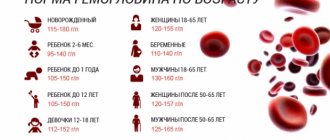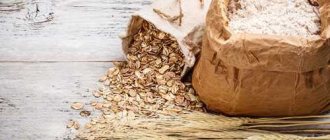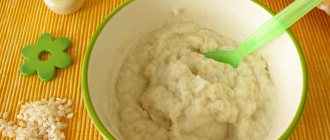What is hemoglobin?
Hemoglobin is a protein that is part of red blood cells (erythrocytes), which in turn consists of two proteins: heme (to which oxygen is directly attached) and globin, a simple spherical protein. The function of red blood cells is that they carry and deliver oxygen molecules to the cells of the body. Iron, Fe, occupies a central place in the composition of the hemoglobin molecule. Insufficient levels of this protein in the blood lead to oxygen starvation, which may result in physical and mental underdevelopment of the child.
Normal hemoglobin level in blood. What will help you achieve it?
Hemoglobin levels are measured in grams per liter (g/L). Before the child turns one year old, the rate of this indicator gradually decreases. What level is normal at this age?
| 1-3 days | 145-225 |
| 7 days | 135-215 |
| 14 days | 125-205 |
| 1 month | 100-180 |
| 2 months | 90-140 |
| 3-6 months | 95-135 |
| six months to a year | 100-140 |
Reasons why a baby's hemoglobin is low:
- maternal anemia, especially during pregnancy (about half of pregnant women have low levels of red blood cells)
- fetal prematurity;
- if there is more than one child in the womb, there are twins;
- during pregnancy, the woman had infectious diseases, poisoning, and the child had hypoxia;
- if the newborn's umbilical cord was tied before it stopped pulsating;
- surgical operations of a newborn, large blood loss;
- intense changes in the baby’s body associated with rapid growth affect blood production (therefore, the level of certain blood cells may fluctuate);
- heredity.
The health of the child is almost 100% influenced by the health and lifestyle of the mother. The supply of iron that she accumulated during pregnancy will serve the baby during the first six months of his life. Further feeding with mother's milk with the mother's correct diet will maintain the required level of red blood cells in the infant.
A newborn must have an iron supply. Because when he is born, his total hemoglobin is 80% fetal hemoglobin, which subsequently breaks down. Over time, hemoglobin is formed, as in adults. Therefore, at first, a child needs a supply of this valuable protein for the normal functioning of its organ systems.
When the child grows up (he is already 6 months old), he begins to be fed “adult” food. Such nutrition will help the new little person regulate its level of microelements, including iron. The main thing is to know how to eat properly.
Why is low hemoglobin dangerous in a child?
As we get older, the normal amount of iron protein changes. Thus, protein reaches peak values in the first 2 weeks of a newborn baby’s life (up to 200 g/l). Afterwards there is a gradual decrease.
Hemoglobin is of great importance for the health of the newborn. Low hemoglobin levels in a child are observed if he has congenital genetic abnormalities or was born premature.
Low hemoglobin can also be observed with late introduction of complementary foods, artificial feeding (especially with improper selection of formulas), impaired absorption of microelements and vitamins in the intestines, feeding with cow's milk, insufficient breastfeeding, as well as in the presence of iron deficiency anemia in the mother, etc. d.
After the first year, the normal value of the indicator begins to gradually increase; up to 10 years, the reference values are in the range from 115 to 145 g/l.
During the period of preparation of a child for the onset of puberty, a restructuring of the endocrine and reproductive systems occurs. At the age of 10 to 12 years, normal hemoglobin is in the range from 120 to 150 g/l.
From the age of 15, reference values for boys and girls begin to differ. The value of the indicator in girls (115 – 155 g/l) is slightly lower than in boys (125 – 160 g/l).
The indicator is highly sensitive to the influence of external factors, time of year, as well as lifestyle and place of life. People living in high altitude areas (poor oxygen) have relatively higher levels of iron-containing protein.
Main article: Hemoglobin norm in children by age from newborns to 18 years
In order to determine the cause of low hemoglobin in children, comprehensive laboratory diagnostics are necessary. By what signs can parents understand that the level of iron-containing protein in a child is less than normal:
- the baby’s skin turns pale and becomes dry, hair and nails become dull and quickly break;
- a gray or yellowish complexion is noted;
- cracks and sores appear in the corners of the lips; in extremely severe cases, the palms and feet become covered with cracks;
- there is a high susceptibility of the child to infectious diseases due to a decrease in the body’s natural defenses;
- behavior is characterized by lethargy, increased tearfulness and drowsiness, as well as irritability and fatigue too quickly;
- there is sluggish breastfeeding and frequent regurgitation;
- the child is not gaining weight well;
- Lack of hemoglobin also affects the functioning of the digestive system. The baby is worried about nausea and vomiting, problems with stool. There have been cases when, with a lack of iron-containing protein, children showed interest in chalk and lime, starting to chew them;
- young patients are worried about low blood pressure, rapid heartbeat and fainting;
- the child may often complain of headaches and dizziness.
At the first signs of low hemoglobin, you should immediately contact your pediatrician for a comprehensive examination and selection of competent treatment methods.
The above signs, despite their numerousness, are not very specific. They can accompany diseases of various etiologies.
If parents notice a decrease in the child’s performance at school without obvious reasons and constant drowsiness, then it is necessary to undergo a laboratory examination. It is important to show attention to the child and not attribute the decline in academic performance to laziness.
A study to determine hemoglobin levels should be carried out at least once a year. After suffering from infectious diseases (viral, bacterial or fungal), a hemoglobin test is also required.
According to statistical data, the incidence of low hemoglobin is significantly higher than high hemoglobin. According to the World Health Organization, 47.5% of children under 7 years of age have a lack of hemoglobin; in schoolchildren, the incidence is 25.5%.
A prolonged lack of hemoglobin leads to insufficient oxygen supply to organs and tissues, especially the brain. As a result, the baby may begin to lag behind his peers in development. In addition, low hemoglobin is a factor that stimulates the development of pathologies of the heart and kidneys, as well as the immune system and skin.
Patients may be concerned about frequent infectious diseases, constant weakness, dizziness, fainting, muscle pain, heart rhythm disturbances, itching and dry skin, brittle nails, hair loss, etc.
In the absence of competent methods for correcting the condition, the child may have cardiomyopathy, extrasystole, persistent tachyarrhythmia, etc.
To determine the level of hemoglobin in the blood, the Sali method is used, which is based on mixing hydrochloric acid with distilled water, and automated methods using a hemometer. This complex protein is designated by the letters Hgb. For each age, there is a norm for this indicator, deviation from which more or less may indicate disturbances in the hematopoietic system associated with a lack or excess of iron.
The normal Hgb level in the blood of children is presented as a double indicator. The first is the minimum allowable value, the second is the maximum allowable value. So, in infants in the first three days of their extrauterine life, the permissible hemoglobin content in the blood is a value within the range from 145 to 225 g/l.
In the 1st month, this indicator should be in the range from 100 to 180 g/l, in 2 months - from 85 to 145 g/l, from three months to 6, the Hgb norm in the child’s blood ranges from 95 to 140 g/l. l. In children from six months to two years, this figure should not be lower than 105 or higher than 145 g/l. From two to six years old, the Hgb norm is 115–135 g/l, from 6 to 12 years old – 120–145 g/l, in teenage boys – 120–160 g/l, in teenage girls – 112–152 g/l.
We invite you to familiarize yourself with Tutta Larsen's personal life, children
As for proper nutrition, it can only maintain the desired level of Hgb, but as a therapy it will be ineffective. In addition, according to a respected doctor, hemoglobin levels cannot be raised by just snapping your fingers. This will take at least three months, two of which will take to reach the desired level, and the third to build up iron reserves in the body.
Depending on the age of the child, the reasons for the decrease in vital protein may vary.
As for newborn babies, due to blood loss, increased destruction, or even a disruption in the production of red blood cells, the child may experience anemia:
- A baby may lose a significant amount of blood during childbirth; this occurs when premature placental abruption or umbilical cord rupture occurs.
- A low level of hemoglobin can also occur in the case of increased breakdown of red blood cells, while the bone marrow cannot cope with the production of new proteins due to its underdevelopment. Similar phenomena are often observed in premature babies aged 1–2 months.
- Some diseases can also lead to increased breakdown of hemoglobin, such as hemolytic disease of the newborn. At the same time, the antibodies that he received from the mother act in the child’s body. They are the ones who destroy the red blood cells of the fetus.
- A hereditary disease such as spherocytosis is the cause of anemia in infants. Hemoglobin breaks down quickly due to the irregular, spherical shape of red blood cells.
- The cause of rapid destruction of red blood cells can also be an intrauterine infection received by a child, for example, rubella, herpes simplex or syphilis.
- If the intake of iron from the diet is insufficient in children, even with an initially normal hemoglobin level, it can decrease by the age of 6 months, since the reserves received from the mother by this time are depleted.
As for children of preschool and school age, they have other reasons for a decrease in hemoglobin levels in the blood:
- Most often in older age, the main reason is the child’s poor nutrition. But you should understand that it is not enough to simply feed your child foods rich in iron. It will be absorbed only if certain vitamins and minerals (copper and manganese) are present in the body. As studies conducted by WHO have shown, this process is greatly facilitated by ascorbic acid. When it is present in the body, the absorption of both organic (contained in products) iron and in the form of medications occurs very quickly and almost completely.
- If a child has a deficiency of folic acid and vitamin B12, the production of red blood cells is disrupted, and as a result, anemia will not take long to occur. This often happens because the baby receives few vegetables during the period of active growth, or they are cooked for too long.
- The reason for the decrease in the level of hemoglobin so necessary for the body can be various bleedings, both obvious and occurring in a latent form. As for the first, for girls who are in the phase of puberty, this is most often the beginning of menstruation. If the discharge is abundant, then in most cases the hemoglobin level decreases. But with the right approach to nutrition, no additional funds are required. Also, if there are errors in the menu, hemorrhoids can develop, due to even small but regular blood losses, the treasured protein becomes less, and doctors can diagnose anemia. Naturally, due to various types of wounds and injuries, bleeding may occur, which will inevitably lower the level of hemoglobin. As for hidden bleeding, in children they can be observed with gastrointestinal diseases.
- Another reason leading to the problem described above may be an incorrect lifestyle, namely: if a child spends little time outside, does not move, does not play sports, then it is natural that his metabolism is disrupted. This will inevitably lead to low iron levels in the blood. But it is worth considering that, on the contrary, increased physical activity can lead to a similar reaction of the body, when a child is engaged in physical labor that is beyond his strength or in a sport that is too difficult.
- Taking certain medications in childhood, especially without medical supervision, can lead to anemia.
How to increase hemoglobin levels and maintain them?
If you notice at least some signs of anemia, you should contact your pediatrician and take blood tests for hemoglobin. If necessary, you should visit a hematologist.
Usually, to eliminate anemia, the patient undergoes an outpatient course of treatment (at home), taking iron-containing medications that are suitable for infants. If the baby already eats a variety of foods, then his diet should be balanced and contain foods rich in iron, manganese and copper. If the child is fed only breast milk, then the mother should take iron supplements and have appropriate nutrition. If the signs of low hemoglobin in a baby do not go away, you need to undergo hospital treatment.
Periodically (every 2-3 weeks) you need to undergo tests to monitor what the baby’s hemoglobin level is at the moment. So, the norm of this protein in children in infancy is achievable with proper treatment and nutrition.
How to increase hemoglobin in a child?
If a child’s Hgb is low due to IDA, then the doctor prescribes therapy with medications that contain iron (Ferrograd, Hemofer, Maltofer, Tardiferon, Ferretab, Ferrum lek, Aktiferrin, Irovit, Totema, etc.). The dose depends on the age of the patient. If hemoglobin is low in a child who is less than a year old, then he is prescribed medications in liquid form - syrup or drops. For older children, medications are prescribed in the form of chewable lozenges or tablets.
The course of treatment for IDA is on average 3 months. After its completion, repeated tests are taken to monitor hemoglobin levels. The positive effect of taking the drugs should occur within a month. If this does not happen and the hemoglobin level remains low, this means that the medication is not suitable and needs to be changed.
Diet changes
It will also be very beneficial for your baby to drink fruit compote or rosehip tea. You can also give pomegranate juice to drink, diluted in a 1 to 1 ratio with boiled water.
We suggest you read: Why do your legs swell?
Children from two years of age should include easily digestible iron-containing foods such as veal, beef, pork, lamb and rabbit in their menu. A large supply of iron is contained in offal. Seafood is also rich in iron, but should be administered with extreme caution as it can cause a serious allergic reaction in a child.
Foods such as bread, soy, buckwheat, and lentils can increase hemoglobin levels. A child with low hemoglobin levels should eat as much fruit, vegetables and berries as possible.
During the treatment period, it is very important to give your child foods with high levels of vitamin C, which helps iron be absorbed by the body faster. For this reason, lemons, oranges, grapefruits, kiwis and paprika should appear in the daily children's menu as often as possible (if there is no allergy to them).
In addition to a special diet, the doctor will strongly recommend monitoring the child’s healthy lifestyle to increase hemoglobin levels. The baby should be in the fresh air for at least 4 hours a day. It would be a good idea to air his room daily.
The degree of activity of the child plays a significant role in the treatment of IDA. The baby should be active, play sports (morning exercises also count), and participate in outdoor games. In addition, the doctor may prescribe hardening and breathing exercises.
Folk recipes
In folk medicine, there are many recipes that can be used to increase the level of hemoglobin in the blood of children. For example, a decoction of nettles. It can be given to babies from a very early age. To prepare a medicinal decoction, you will need to boil water and pour one tablespoon of herbs into it. The resulting product must be infused for thirty minutes and given to the baby three times a day. Nettle can also be used as an ingredient in vegetable salad.
Freshly squeezed beet juice, as well as rowan juice, are considered one of the best remedies for treating anemia. You can also increase your child’s hemoglobin level with vegetable juice made from radishes, carrots and beets. To prepare it, you will need to squeeze the juice from each root vegetable and mix everything in equal proportions. The resulting product should be given to the baby one spoon before meals for three months.
Let's look at a few more of the most effective folk methods for treating anemia:
- 100 grams of prunes, dried apricots, raisins, walnuts (peeled) and one lemon should be mixed and chopped using a blender. Next, add 200 ml of honey to the resulting mass, mix everything well and put it in the refrigerator. After hardening, give the child a teaspoon (or two) twice a day, regardless of meals.
- To prepare this medicinal decoction you will need one tablespoon of rose hips and 200 ml of boiling water. The berries are placed in a thermos, poured with boiling water and allowed to brew for at least two hours. The liquid from the thermos is filtered. Next, add a slice of lemon and 1 tsp. honey The baby should drink the medicine received in two doses (half in the morning, half in the evening).
- Take three types of juices: carrot (50 ml), apple (100 ml) and beetroot (50 ml) and mix. Before taking the medicine received, the baby is given 1 tablespoon of sour cream. Take the drug once a day (usually at lunch). If the baby cannot drink everything at once, the juice should be divided into 2 doses.
- Boil 200 ml of water and pour it into a thermos. Place 30 grams of rose hips in there and let it brew for at least three hours. Afterwards, the broth should be strained and sweetened by adding 10 g of honey. You can also add a slice of lemon to the remedy. The baby should drink 100 ml of this infusion in the morning and evening.
- St. John's wort (3 spoons), nettle (2 spoons), chamomile (3 spoons) and blackberries (2 spoons) are ground into a homogeneous mixture. Afterwards, the resulting composition is poured with three glasses of boiling water and infused for at least three hours. The resulting drug is given to the child warm in a volume of 250 ml three times a day.
Depending on the severity of anemia, you can increase the child’s hemoglobin in the following ways:
- If the readings drop below 110 g/l, but do not go beyond the 100 mark, then you should adjust the baby’s diet and thus try to increase the hemoglobin level. To do this, it is very important to eat not just meat products, but in combination with vegetables. So the percentage of iron absorbed in the intestines increases significantly. But you should forget about drinks such as milk, tea and coffee. Pediatricians often prescribe ascorbic acid. A dentist should be consulted to rule out gingivitis, as the child may lose blood when brushing their teeth. After adjusting the diet, a repeat blood test is performed, and if no improvement is observed, then appropriate medications are prescribed.
- If the indicators have reached the limit of 100 g/l, but not lower than 90, then you should take medications containing iron. Their choice should be taken especially carefully, so in order to avoid many complications and improve absorption, preference should be given to 3-valent iron contained in tablets. Most often, the duration of the course is a month, after which a control blood sample is taken; if an increase in hemoglobin is observed, then the drugs are taken for another 60 days. All treatment must be carried out under the supervision of a doctor.
- If the level has reached 60 - 90 g/l, then one should proceed from the general condition of the child. Depending on it, either iron solutions are taken orally or intramuscular injections are prescribed. Blood counts are monitored every 10 days; self-medication is unacceptable.
- When hemoglobin drops below 60 g/l, an emergency transfusion of red blood cells is prescribed, since such conditions are a direct threat to life, primarily affecting the brain.
It should be remembered that all treatment is carried out under the supervision of a doctor; hospitalization is required only in the latter case, with severe anemia. At the same time, it is important for parents to remember that a balanced diet in combination with regular examinations is the best prevention of iron deficiency anemia.
Author of the article: Praskovya Fedorovna Sokolova, pediatrician
We suggest that you familiarize yourself with the formation of fungus on the heels of the feet. Methods of treatment and prevention
‹
25 products for memory and intelligence
7 Reasons to Do Squats Every Day!
›










